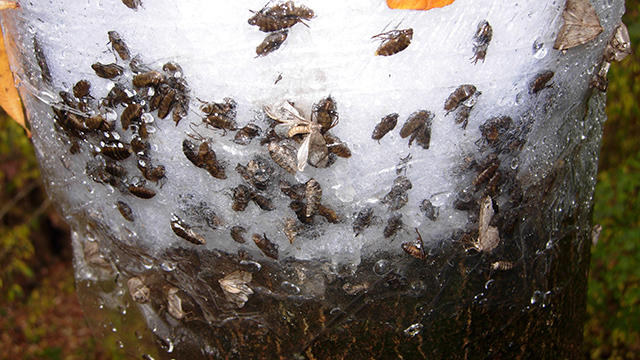Burlington Facing a “Disgusting” Insect Infestation
Published July 17, 2017 at 11:54 pm

If you’ve noticed some nasty little beasties in Burlington’s Tyandaga and Mountainside Park areas, you’re not alone — there are indeed yucky creatures living among us.
If you’ve noticed some nasty little beasties in Burlington’s Tyandaga and Mountainside Park areas, you’re not alone — there are indeed yucky creatures living among us.
“Cankerworm is widespread this year throughout the GTA, including the City of Burlington,” said manager of urban forestry Barbara Rabicki, adding woodlands and ravines in those areas “have sections that are suffering noticeable pest damage.”
At least a dozen calls of concern have been fielded by forestry staff from residents inquiring about the insects, a native pest.
So what’s the big deal about spotting some worms here or there?
“The larvae eat the leaves of the host trees, causing defoliation,” said Rabicki.
The trees generally produce new leaf growth again later in the season.
Trees are able to withstand short-term damage, “however, trees that are stressed over a number of years may suffer long-term damage,” potentially resulting in decline or death.
“At this time, there is no indication that long-term damage will occur,” Rabicki said.
“Stresses such as this are part of nature.”
And it turns out our neighbours to the east are also stressing.
According to a disturbing CityNews report (well, disturbing if you—like most people—hate worms and worm poop), parts of Mississauga have been overwhelmed by an influx of cankerworms.
CityNews reported last month on Lorne Park residents in the Lakeshore area observing “thousands and thousands” of cankerworms taking refuge in their trees (many of which are quite picturesque and mature) and leaving “a disgusting trail of feces in their wake.”
According to the report, the copious amounts of insect poop have created piles of slush that are making residents wary of leaving their homes.
Forestry staff in Mississauga were instructed to deliver a notice regarding a cankerworm and gypsy moth ground spray program to residents, according to Ward 2 Coun. Karen Ras.
Information posted by the City of Toronto describes the fall cankerworm —a native insect— as one of the most “damaging defoliators” of urban forests.
Often called inchworms, loopers or spanworms, the tiny little beasts can be green or brown and their larvae typically hatch and begin feeding on leaves in the spring. After four weeks, the larvae move to the ground and enter the soil. In the fall, the larvae emerge as adult moths.
Back in Burlington, Rabicki says forestry staff will continue to monitor the situation to determine if further action is needed.
“Infestation levels tend to increase as part of natural cycles, every eight to 12 years, with trees able to withstand the defoliation well,” said Rabicki.
“Tree banding with sticky bands may be undertaken in some of the most impacted areas should the cankerworm levels persist.”
WHAT TO DO?
There are some steps residents can take to protect their trees, such as installing bands around the main stems of the host trees in late October to prevent cankerworm attachment, according to the City of Burlington
Residents can also work to attract birds and ground beetles by planting herbs, flowers, shrubs and groundcovers around the trees, releasing predatory insects such as parasitic wasps, the City of Toronto advises, and limiting synthetic pesticide use that could harm said predatory insects (they do eat the worms, after all).
For more information on cankerworms click here.
Photo courtesy of the City of Toronto
insauga's Editorial Standards and Policies advertising





